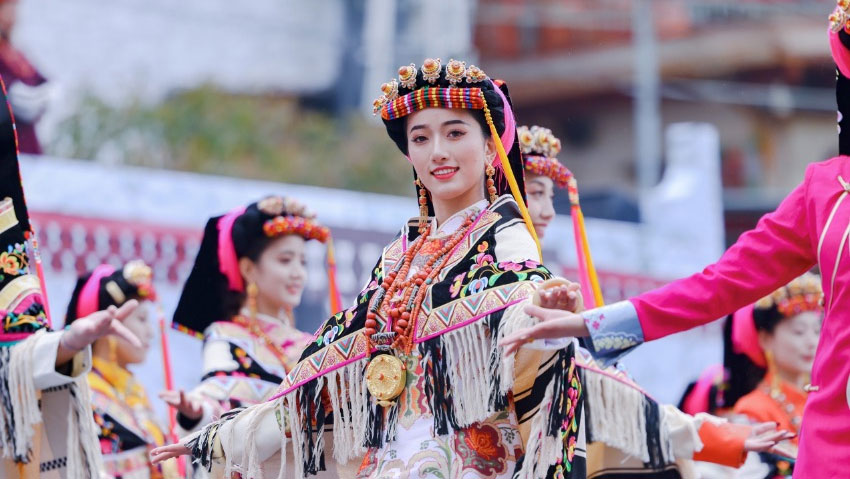Indigenous residential schools probe tells U.S. dark history of genocide
BEIJING, Nov. 2 (Xinhua) -- The Colorado Historical Society's latest investigation into the inhumanities in indigenous residential schools has once again exposed U.S. dark history of racial genocide against the Native Americans.
The investigation report said more than 1,000 Indian children from dozens of tribes attended two major boarding schools from 1892-1909, during which at least 67 died. Inhumane treatment and physical abuse were widespread in both schools.
This probe followed the Federal Indian Boarding School Initiative Investigative Report released by the Interior Department in May last year, which discovered over 500 deaths at 408 federally-run Indian boarding schools.
Institutions as such were intended for identity alteration, with goals of territorial dispossession and forced assimilation. Manual labor of children and tribal trust accounts were used to supplement federal funding to run those schools, said the federal report.
As the U.S. mainstream society gives more attention to deliberate destruction of the Native Americans, more aging survivors and descendants of victims have spoken up about their sufferings, warning that the country has yet a long way to go before true reparation is made.
GENOCIDE CAN'T GET WHITEWASHED
"I thought there was no God, just torture and hatred," 78-year-old Rosallie Whirwinder Solide told The Associated Press as she recalled being locked in a basement at St. Francis Indian Mission School in South Dakota for weeks as punishment for breaking the school's strict rules.
Solide was sent there at 4, where her hair braids, a symbol of Indian girl status, were cut off, and her native language was depicted as "the devil's language."
"The only thing they didn't do was to put us in (an oven) and gas us," she said, comparing the treatment of the Native Americans in the 19th-20th centuries to the Jewish Holocaust during World War II.
The United States did not recognize the citizenship rights of Indian Americans despite its independence in the 18th century. It had rather implemented bloody killings, violent expulsion and resources looting against them for more than a century.
Since the U.S. Congress passed the Civilization Fund Act in 1819, a series of laws and policies have been formulated to promote the establishment of Indigenous boarding schools across the country, in an attempt to kill, annihilate, or assimilate Indigenous people and eradicate their cultures.
Richard Henry Pratt, who founded the Carlisle Indian School in Pennsylvania in 1879 as the first off-reservation Indian boarding school, was well-known for his credo "Kill the Indian, and Save the Man," meaning to eradicate any signs of Native life and practices, including cutting hair and braids of the children, banning Indian languages or customs, forcing the Christianity and Christian dogma and practices, even forbidding hugging among siblings.
Many children in the schools suffered beatings, malnutrition, hard labor and other forms of neglect and abuse. Some never returned to their families. The federal report said more than 50 schools were found to have marked or unmarked graves, and over 500 Indian children died, with the number expected to reach thousands or even tens of thousands as investigation continues.
The intention was "to assimilate them (the Indian children) and steal everything Indian out of them except their blood, make them despise who they are, their culture, and forget their language," said Lacey Kinnart, who works for the Minnesota-based National Native American Boarding School Healing Coalition.
The decades-long boarding school system, a particularly ugly chapter of U.S. history, was a form of genocide which complies with the UN's definition of genocide, said Barbara Landis, who had worked for decades as Carlisle Indian School biographer for the Cumberland County Historical Society in Pennsylvania.
"I don't think there's any way to whitewash that," said Landis, who has maintained a website to forward names of the former Carlisle Indian School students to their respective nations since 1993.
LAND-GRAB UNIVERSITIES
The United States boasts some of the world's most prestigious universities, but until recent years little had been known about the fact that its higher education was largely founded on the seizure of Indigenous land and eradication of Indigenous people.
In 1862, the U.S. federal government passed the Morrill Act, granting federal land to the states for the development of higher education, with land often taken from Indian Americans through unequal settlements, extortion or slaughter.
As a result, 10.7 million acres (about 43,301.3 square km, an area nearly twice the size of New Jersey) of land belonging to about 250 Indian tribes were forcibly bought or seized at low prices. Fifty-two universities nationwide became beneficiaries of the law, such as Cornell University, the University of California, and the Massachusetts Institute of Technology. Many small (now mostly liberal arts) colleges dotting the Northeastern, Mid-Atlantic and Midwestern states, as well as the towns and farms around them, were placed on dispossessed Native lands, as revealed by the High Country News magazine in its report series published in 2020.
Some of those plundered lands were sold quickly, allowing American colleges and universities to reap huge profits. For example, 160 acres of land were bought by the federal government from the Indians at a low price, then transferred to the state of Mississippi to fund Alcorn State University and Mississippi State University, and later sold by the two universities.
The University of Minnesota's founders even "committed genocide and ethnic cleansing of Indigenous people for financial gain, using the institution as a shell corporation through which to launder lands and resources," said a 500-page report jointly released by the Minnesota Indian Affairs Council and the university in April.
The Morrill Act provided the university a financial bonanza -- dubbed the "Minnesota windfall" -- that channeled more than 500 million U.S. dollars to the fledgling University of Minnesota from leases and sales of land taken from the Dakota tribe after the federal government hanged 38 Dakota men in Mankato, Minnesota in December 1862, ending the U.S.-Dakota war, it said.
Meanwhile, the university's permanent trust fund controls roughly 600 million dollars in royalties from iron ore mining, timber sales and other revenues derived from land taken from the Ojibwe and Dakota tribes, it added.
"There would be no higher education as we know it in the United States without the original and ongoing colonization of Indigenous peoples and lands, just like there would be no United States," said Sharon Stein, an assistant professor of education at the University of British Columbia in Canada. "There is no moment or time or place or institution that is not deeply entangled with the violence of colonialism."
"IT HAS NOT CHANGED"
Historical records and media reports showed that since its founding, the United States has systematically deprived Indian Americans of their rights to life and basic political, economic and cultural rights through killings, displacements and forced assimilation to physically and culturally eradicate this group. Such an existential crisis endures today.
The genocide has led to a precipitous drop in the population of Indian communities, deterioration of their living conditions, lack of social security, low economic status, threats to their safety, and plummeted political influence.
Before the arrival of White settlers in 1492, there were 5 million Indians, yet by 1800 the number dropped to 600,000, and by 1900 to only 237,000, the lowest in history. More than a dozen tribes, such as the Pequot, Mohegan, and Massachusetts, were by then completely extinct.
According to the 2020 U.S. Census, Native American groups, including Indians and Alaska Natives, accounted for merely 2.9 percent of U.S. population. There is a general fear that their languages and cultures will be swallowed up by English and Spanish cultures.
Many Indian Americans are still struggling at the bottom of the U.S. society, living without security and suffering from systemic racial discrimination. Of all ethnic groups in the country, the Native Americans have the lowest life expectancy, the highest rates of poverty and youth alcoholism, and the lowest doctor-to-patient ratio in their communities.
"The colonial genocide of Indigenous people was the first root planted in the formation of America. That root remains a fundamental anchor of American society and one that permeates American culture," said Roberto Sirvent and Danny Haiphong in their book "American Exceptionalism and American Innocence: A People's History of Fake News -- From the Revolutionary War to the War on Terror."
"I can't excuse that. It's racism. And we have to confront that. It has not changed. What happened 135 years ago is still a problem in our country," Landis told Xinhua.
For Landis, there has to be better awareness in education about this particular aspect of U.S. history before there can be an apology, and the Indigenous voices need to be heard much more before any kind of reconciliation can come.
"I don't think that this country is ready for an apology," she said.
Photos
Related Stories
- U.S. military in Finland to remain under U.S. jurisdiction: ambassador
- Biden picks Asia policy heavyweight Kurt Campbell as deputy secretary of state
- U.S. infant mortality rates rise for first time in over 20 years
- Donald Trump Jr. takes witness stand in New York civil fraud trial
- U.S. Fed leaves interest rates unchanged amid surging Treasury yields
Copyright © 2023 People's Daily Online. All Rights Reserved.









